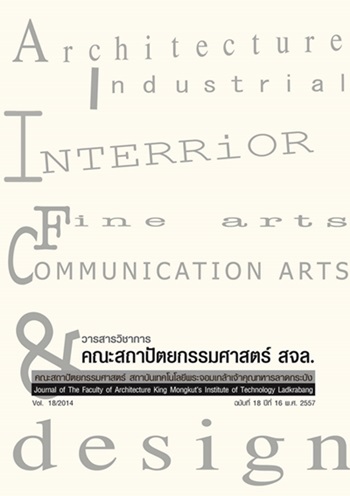ปัจจัยที่ทำให้เกิดความคิดสร้างสรรค์ในวิชาวิเคราะห์การออกแบบ สาขาวิชาสถาปัตยกรรมและการวางแผน คณะสถาปัตยกรรมศาสตร์ สถาบันเทคโนโลยีพระจอมเกล้าเจ้าคุณทหารลาดกระบัง
Main Article Content
Abstract
บทคัดย่อ
ปัจจุบันมีหลากหลายวิธีในการรับข้อมูลข่าวสารซึ่งมีความรวดเร็วและทันสมัย ทำให้การพัฒนาปรับปรุงการเรียนการสอนนั้นต้องมีการปรับตัวตาม ทั้งนี้ในระบบการเรียนร้ตู้องมีการพัฒนาร่วมกันระหว่างผู้สอนและผู้เรียน โดยเฉพาะผู้วิจัยได้ให้ความสำคัญกับวิธีการวิเคราะห์การออกแบบ โดยการวิจัยนี้มีจุดประสงค์เพื่อวิเคราะห์ความสัมพันธ์ของปัจจัยที่ทำให้เกิดกระบวนการสร้างแนวความคิดสร้างสรรค์ จากการเรียนวิชาวิเคราะห์การออกแบบ และนำผลการวิเคราะห์ไปใช้ในการพัฒนาการเรียนการสอนในรายวิชานี้ จากการทบทวนวรรณกรรม แสดงว่าผู้ที่จะสร้างความคิดสร้างสรรค์ ต้องเรียนรู้หลักการออกแบบอันเกิดจากการรับรู้ด้านการมอง เรียนรู้และวิเคราะห์องค์ประกอบของการออกแบบ และ หลักการออกแบบพื้นฐานโดยผู้เรียนต้องผ่านการวิเคราะห์งานจริง จะสร้างความเข้าใจและความทรงจำให้นักศึกษาได้ดีที่สุด ในการวิจัยนี้ได้ใช้การทดสอบด้วยวิธีการปฏิบัติในห้องเรียนและการปฏิบัตินอกสถานที่ รวม 4 วิธีการทดลอง คือ 1) ผู้สอนเลือกภาพถ่าย มาบรรยายและวิเคราะห์งานสถาปัตยกรรมภายใน 2) ผู้สอนเลือกภาพถ่าย ให้ผู้เรียนสเก็ตช์พร้อมวิเคราะห์งานสถาปัตยกรรมภายใน3) นักศึกษาเลือกภาพถ่าย ให้ผู้เรียนสเก็ตช์พร้อมวิเคราะห์งานสถาปัตยกรรมภายใน และ 4) นักศึกษาออกภาคสนามให้ผู้เรียนเลือกมุมมองสเก็ตช์ในสถานที่จริงพร้อมวิเคราะห์ แล้วประเมินความคิดสร้างสรรค์ด้วยการตรวจผลงาน และประเมินความเข้าใจในการวิเคราะห์ กับประเมินความพึงพอใจในการเรียนด้วยแบบสอบถาม ผลการวิจัยแสดงว่าวิธีที่ 2 ทำให้ผู้เรียนเกิดความเข้าใจ และวิธีที่ 4 ทำให้เกิดกระบวนการสร้างสรรค์ และเป็นที่พึงพอใจของผู้เรียนที่สุด จึงเห็นสมควรเน้นการศึกษาด้วยวิธีทดลองที่ 2 และวิธีการทอลองที่ 4 เพิ่มในการเรียนการสอนในวิชาวิเคราะห์การออกแบบ
คำสำคัญ: ความคิดสร้างสรรค์ ปัจจัย วิเคราะห์ สถาปัตยกรรมภายใน ออกแบบ
Abstract
Currently, there are various ways to get information, which is very fast and up-to-date. Hence, toimprove the learning system, learning and teaching approach must be adapted from both the instructors’ andthe students’ point of views. In particular, research has focused on how to analyze the interior space. Thestudy is to analyze the relationship of the factors that contribute to the creative process to students in thef ield of Interior Architecture. The results of this research will be used to improve teaching and learning in thiscourse. The literatures suggest the creativities were built by the “visual perception”, designers can be learnedand analyzed by the design elements and design principles. The research method consists of four experiments:1) Instructor describing and analyzing the interior space, 2) Students sketch and analyze the interior space f igures that are selected by the instructor, 3) Students sketch and analyze the interior space figures that areselected by student themselves, and 4) Students sketch and analyze the interior space in real locations. Thestudents’ works were assessed by the instructor to evaluate students’ creativity, and questionnaires are used toevaluate the students’ satisfaction in each experiment. The results show that the second experiment suggestedthe students understand how to analyze the interior space. And the fourth experiment formed a creativeprocedure and was more satisfied by the students. The authors concluded that research should focus oneducation by the further focus on the second and the fourth system, and the systems will be applied to thedesign analysis classes.
Keyword: Creativity Factor Analysis Interior architecture Design
Article Details
This work is licensed under a Creative Commons Attribution-NonCommercial-ShareAlike 4.0 International License.
Copyright Transfer Statement
The copyright of this article is transferred to Journal of The Faculty of Architecture King Mongkut's Institute of Technology Ladkrabang with effect if and when the article is accepted for publication. The copyright transfer covers the exclusive right to reproduce and distribute the article, including reprints, translations, photographic reproductions, electronic form (offline, online) or any other reproductions of similar nature.
The author warrants that this contribution is original and that he/she has full power to make this grant. The author signs for and accepts responsibility for releasing this material on behalf of any and all co-authors.


